Book contents
- Antioch on the Orontes
- Antioch on the Orontes
- Copyright page
- Dedication
- Contents
- Plates
- Figures
- Tables
- Contributors
- Abbreviations
- Antioch on the Orontes
- Part I Beginnings
- Part II The Making of a Capital
- Part III The People of Antioch
- Part IV Religion
- Part V Crises and Resilience
- Chapter 27 Earthquakes and State Response at Antioch
- Chapter 28 Disasters and Divine Wrath
- Chapter 29 Infectious Disease and Its Repercussions in Sixth-Century Antioch
- Chapter 30 Memory and the City
- Index
- Plate Section
- References
Chapter 29 - Infectious Disease and Its Repercussions in Sixth-Century Antioch
from Part V - Crises and Resilience
Published online by Cambridge University Press: 06 June 2024
- Antioch on the Orontes
- Antioch on the Orontes
- Copyright page
- Dedication
- Contents
- Plates
- Figures
- Tables
- Contributors
- Abbreviations
- Antioch on the Orontes
- Part I Beginnings
- Part II The Making of a Capital
- Part III The People of Antioch
- Part IV Religion
- Part V Crises and Resilience
- Chapter 27 Earthquakes and State Response at Antioch
- Chapter 28 Disasters and Divine Wrath
- Chapter 29 Infectious Disease and Its Repercussions in Sixth-Century Antioch
- Chapter 30 Memory and the City
- Index
- Plate Section
- References
Summary
Amidst all of the ills that struck Antioch in the sixth century, the bubonic plague ranks high. This chapter addresses the actual entity of the pestilence, calling into question the reports in the ancient sources.
- Type
- Chapter
- Information
- Antioch on the OrontesHistory, Society, Ecology, and Visual Culture, pp. 464 - 488Publisher: Cambridge University PressPrint publication year: 2024

